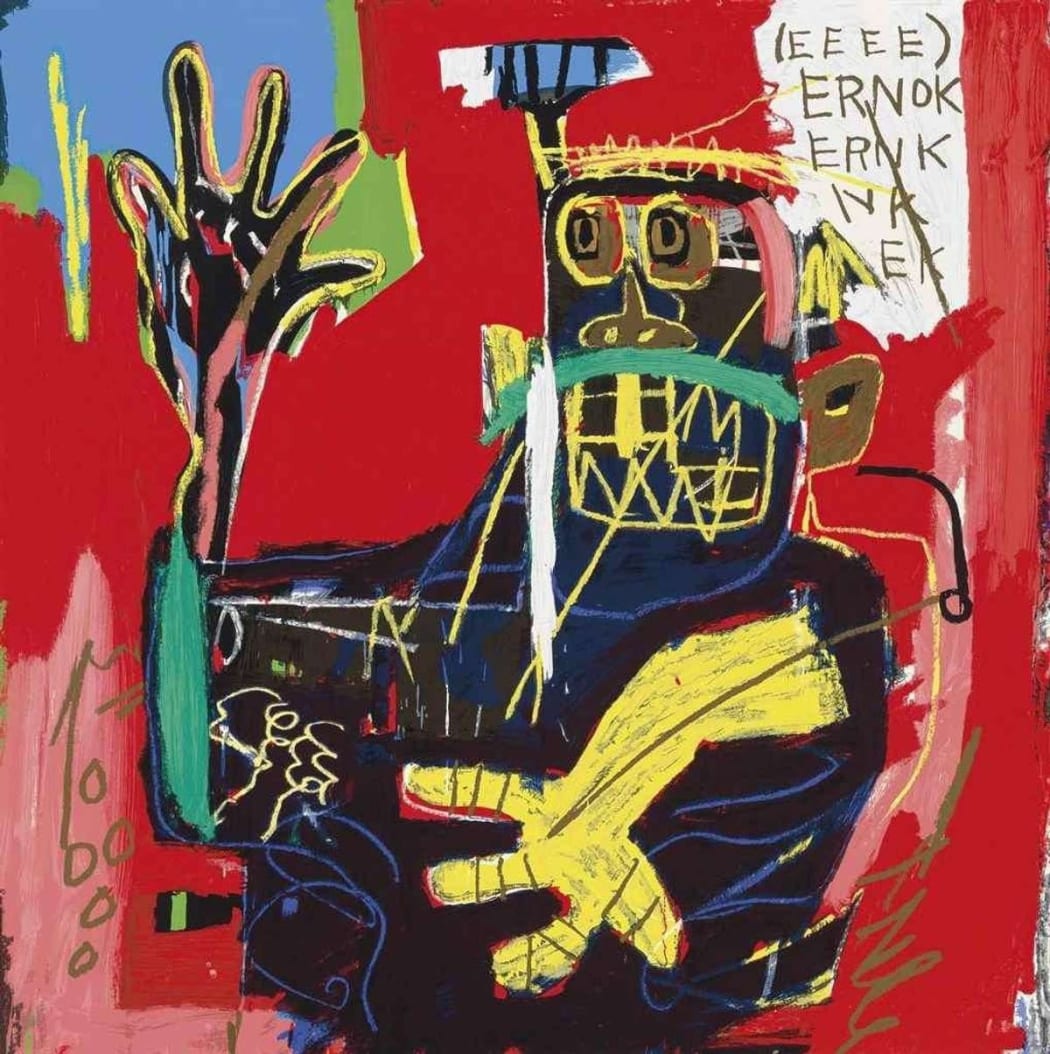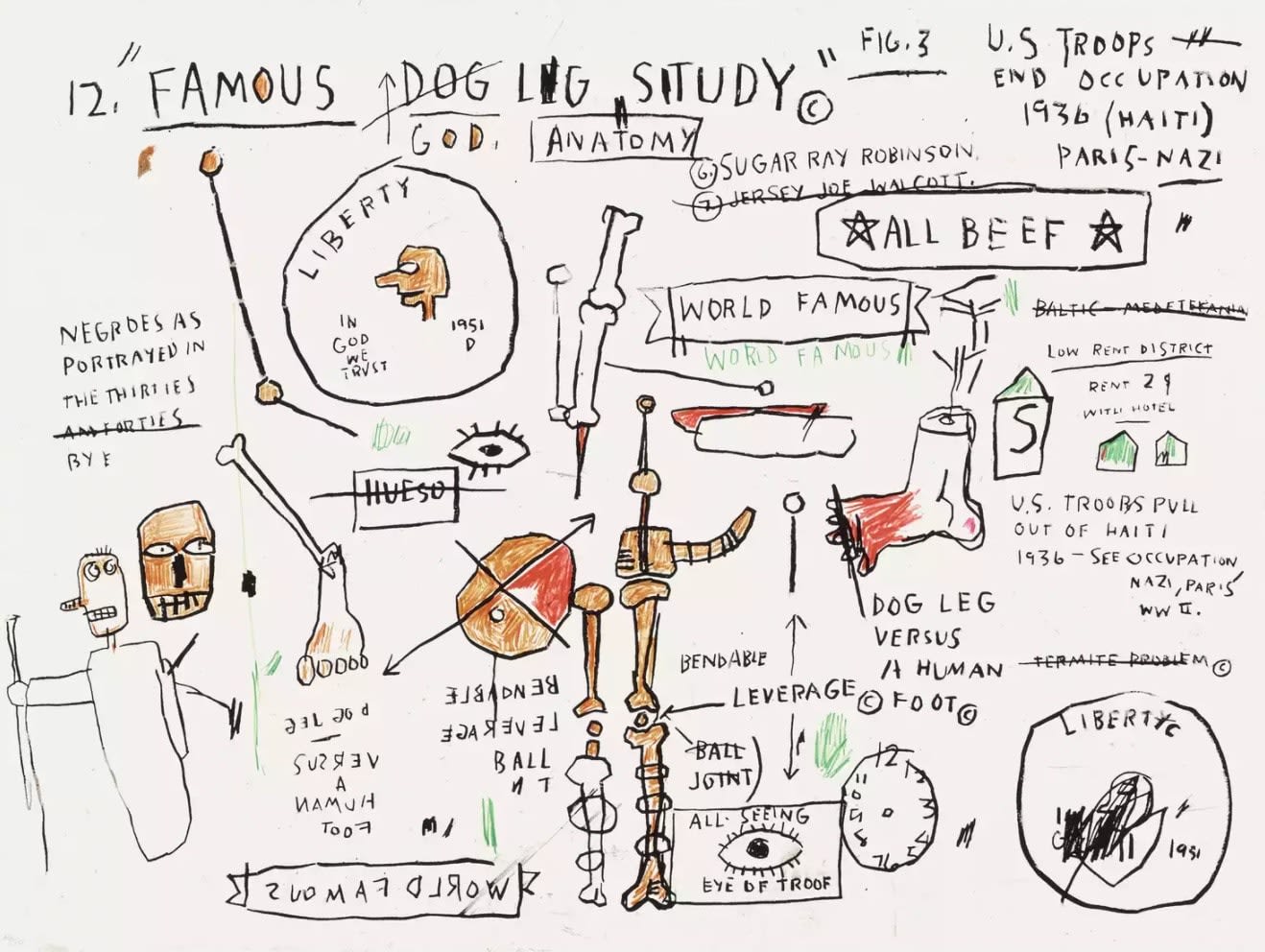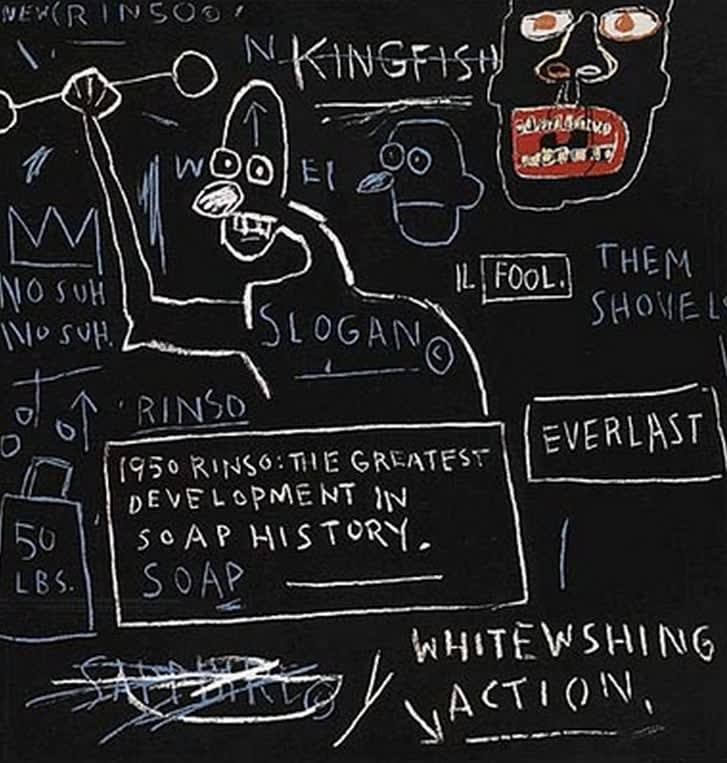
"I'm not a real person. I'm a legend."
A Multicultural Childhood
Born to Haitian and Puerto Rican parents in Brooklyn, Jean-Michel Basquiat grew up in a diverse neighbourhood - but one that was not without the well-known problems of the 1970s in New York. As a child, Basquiat grew up speaking Spanish and French and developed an appreciation of art and culture from a young age. Indeed, at just 6 years of age he became a junior member of the Brooklyn Museum. Basquiat suffered a life threatening injury at 8 years old when he was hit by a car playing baseball in the street with his sister. His mother bought him a copy of the foundational medical textbook Gray’s Anatomy which he became obsessed with whilst recovering. Recalling the gift, his sister Lisane Basquiat said, “One of the gifts that my mother brought to him was the book, ‘Gray’s Anatomy.’ She wanted him to have the opportunity to see his own body, as it related to the way it had to be reconstructed,” Years later, he would name his industrial art noise band Gray after the book. As a teenager, he was thrown out of the house by his father when he dropped out of school at the age of seventeen. Living on the streets, reportedly on a diet of cheap red wine and 15¢ bags of Cheeto, he etched out a living selling postcards with his drawings on and panhandling. It was this first taste of living on the streets that exposed the young Jean-Michel to a world outside his home.

SAME OLD SHIT Or A New Approach To Tagging?
Basquiat first gained public attention through his revolutionary graffiti tag SAMO” (shorthand for “same old shit”). At this time, graffiti was seen as an act of vandalism and often tied to concepts around social decay - as it was most prevalent in run-down areas, the subway and in poorer communities. The style, fairly uniform, was provocative and historically confrontational and violent. Indeed, such was the prevalent explosion of graffiti around this era that the city spent $52m USD between 70 - 78 cleaning walls and the subway with the transit police arresting some 7,000 youths for graffiti or tagging. Basquiat’s tag “SAMO” started to appear that changed the notion of what graffiti was. Indeed, Basquiat would often incorporate philosophical, rhetorical questions. Appearing throughout lower Manhattan and Brooklyn between 1977 and 1980. Finally, Basquiat withdrew the SAMO tag announcing “SAMO is dead”.

A Rapturous Rise to Fame: Selling His First Painting to Debbie Harry
Living on the streets in his late-teens, Basquiat struggled with many of the challenges faced by young, broke, black artists. Whilst his turn in fortunes, from being an unknown to exhibiting in some of the most prestigious institutions in the world. Basquiat lived with his friend Suzanne Malouk, who paid for rent and expenses. Struggling to get the supplies he needed for his art, he would often break into abandoned buildings and use doors, crates and other objects that he could find. Often saying that he would replay the expenses that Malouk had spent when he became rich and famous it was around this time that he sold his first painting to none other than Debbie Harry from the influential band Blondie. Introduced to the star through hip-hop legend Fab 5 Freddy who was appearing in the music video for Blondie’s song “Rapture” Basquiat stood in for Grandmaster Flash who didn’t want to participate. Following his guest appearance in the video Basquiat sold his first painting to Harry for $200. On the sale, Malouk said, ““That was a lot of money to us at that point, so we went out to dinner in a Chinese restaurant on Second Avenue — just an ordinary restaurant — but this was a real treat for us because we were so poor. It was very special and he was so happy and so proud.” You can see a young Jean-Michel in the Rapture video below at minute 1.52.
Multiple Firsts: The First Radical Art Show of the 1980’s.
New York of the 1980’s was a hotbed of creativity and a culture whirlwind was unfolding of which Basqwuiat was starting to find himself at the centre. Set to the backdrop of the birth of Hip Hop, Punk and counterculture, Basquiat’s rise to fame would be meteoric. His first group exhibition took place in June 1980 at an abandoned massage parlour near Times Square which also featured works by his friend Keith Haring amongst others.
With his magnetic personality and talent, he would explode onto the scene and within two years found himself becoming the youngest artist ever to exhibit at Documenta in Kassel Germany in 1982 with his works exhibited amongst Andy Warhol, Joseph Beauys and Gerhard Richter. He would also become the first Black American artist to be represented by Bruno Bischofbergerwho became his worldwide art dealer in the same year. His first solo exhibition, in March 1982, sold out. Basquiat was 21. He was also an instant celebrity, with an impish hairstyle and a print-ready back-story. Basquiat was first introduced to Andy Warhol, with whom he would have a difficult relationship, by Bischofberger who had given Jean-Michel a one-man show at his Zurich gallery. Warhol recalls on meeting Basquiat for lunch on October 4th that, "I took a Polaroid and he went home and within two hours a painting was back, still wet, of him and me together." Basquiat would go on to be the first black artist to feature on the cover of The New York Times Magazine in the article “New Art, New Money” in February 1985. Cathleen McGuigan, on Basquait wrote:
“He is the first art star of the 1980's and created an atmosphere of expanded possibilities for any promising artist since. For someone as ambitious as Basquiat, high expectations are matched by the pressures of succeeding. Basquiat's sometimes-stormy rise and struggle with the art establishment provide a look at how the artists' names and their works are marketed in the art world today. His successful career demonstrates the competitiveness among dealers for artists; dealers' pricing and marketing techniques; their control of supply and demand and the importance of the European market for today's American scene. Further, Basquiat's example shows how an artist tries to create and to preserve his autonomy in this heady environment.”

A Friendship with Warhol
“I think that Andy Warhol was a great influence on Jean-Michel. He didn’t do drugs, he kind of took Jean-Michel around in the international art world and showed him some of the ropes.”
Basquiat and Warhol’s friendship is well documented and it is said that, as a young artist in New York, he looked up to the established Warhol. Collaborating over the years, as an unknown, Basuwqiat spotted Warhol having lunch at a New York restaurant and rushed up to him trying to sell him his postcard drawings. After their meeting in Zurich, Warhol became a patron of sort to Baquiat and would help keep him off of drugs although photographer Paie Powell who was dating Basquiat at the time notes a sense of jealousy of Warhol towards Basquiat, remarking, “jealousy and rivalry going on all the time”. Basquiat lived and worked in an apartment in The Bowery, which was owned by Andy Warhol, from 1983 until his untimely death in 1988.
Becoming close friends, they would work on over 100 paintings together. Usually, Warhol would begin by tracing a Pop Art motif or a news headline onto a canvas and Basquiat would add a symbol, picture, or words to the painting. The artists would have a back and forth sort of joust taking it in turns to add layers to the work. Both artists took imagery from a variety of books, magazines, newspapers, television, advertisements, and, recalling Basquiat’s childhood accident, medical diagrams. It was in 1985 when the relationship began to sour after the New York Times reviewed a joint show by the artists that labelled Basquiat as Warhol’s “mascot.” Friend of Basquiat, Brett De Palma, said “I think Jean became very paranoid and suspicious of even Andy, and felt that, you know, Andy had this reputation of being a vampire and feeding off of younger artists, and needing new blood to infuse his own career.”
Following the show, Basquiat immediately cut ties with Warhol and, sadly, began using the drugs that would take his life at just 27. Overcome by grief from Warhol’s sudden death, Basquiat would become more reclusive and his drug use became heavier.

Basquiat’s impact on art and culture has presented for over 30 years and, even in 2023, we can still see his influence. Whether it is critically acclaimed exhibitions, or record breaking auctions, Basquiat’s shows no signs of slowing down. For more information on our Basquiat original prints for sale, contact Andipa Editions via sales@andipa.com or call +44 (0)20 7589 2371.
